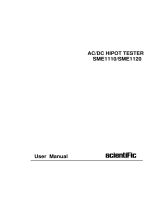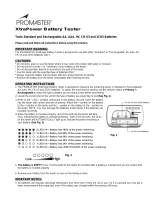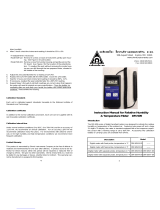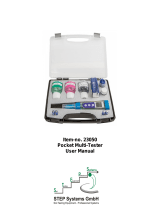Page is loading ...

METRISO 1000A
Insulation tester
3-348-773-37
9/8.18
Operating Instructions

1 2
3
6
5
47
12
13
8 9 107
11
Housing
Attaching the
Strap to the
Housing
METRISO
1000A
M
V
8
8
R3
R2
R1
V
600
400
200
800
0
1000
1000V
4
R1
R2
R3
x0,5
x1
x2
x0,2
x0,1
1000V
500V
250V
100V
50V
BATT
METRISO 1000A
2 GMC-I Messtechnik GmbH
1 Analog display
2 Function selector switch
3 Battery voltage indicator lamp
4 Adjusting screw for mechanical zero adjustment
5 Rotary knob for electrical zero adjustment
6 Rotary switch for nominal voltage selection
7 Studs for fastening the carrying strap
8 Measurement key
9 Test probe with lamp
10 Test probe
11 Alligator clip
12 Latch
13 Carrying strap
Meanings of Symbols on the Instrument
!
Warning concerning a point of danger
(Attention: observe documentation!)
Indicates EC conformity
This device may not be disposed with the
trash. For further details on the WEEE marking,
pleas
e refer to our website www.gossenme-
trawatt.com and enter search key ’WEEE’.

GMC-I Messtechnik GmbH 3
Contents Page
1 Safety Precautions .......................................................................... 3
2 Applications .................................................................................... 4
3 Initial Start-Up ................................................................................ 4
3.1 Battery Installation ...........................................................................................4
3.2 Testing the Batteries .......................................................................................4
3.3 Switching the Tester On and Off .......................................................................4
3.4 Analog Display ................................................................................................4
3.5 Fusing ............................................................................................................4
3.5.1 Checking the Fuse ..........................................................................................4
4 Measuring Direct and Alternating Voltage ...................................... 5
5 Measuring Insulation Resistance .................................................... 5
5.1 Measurement Procedure .................................................................................5
5.2 Evaluation of Measurement Values ...................................................................6
5.3 Rapid Testing of Insulation Resistance ..............................................................6
6 Measuring Low-Impedance Resistance (0 to 4 ) ......................... 6
7 Characteristic Values ..................................................................... 7
8 Maintenance ................................................................................... 8
8.1 Batteries .........................................................................................................9
8.2 Replacing the Fuse ..........................................................................................9
8.3 Testing for Functionality and Accuracy ..............................................................9
8.4 Housing ..........................................................................................................9
8.5 Carrying Bag .................................................................................................10
9 Repair and Replacement Parts Service
Calibration Center
and Rental Instrument Service ..................................................... 10
10 Product Support ............................................................................ 10
1 Safety Precautions
This instrument fulfills the requirements of the applicable European and
national EC guidelines. We confirm this with the CE marking. The relevant
declaration of conformity can be obtained from
GMC-I Messtechnik
GmbH
.
The METRISO 1000A insulation tester has been manufactured and tested
in accordance with the following standards:
IEC 61 010-1/EN 61 010-1/VDE 0411-1,
DIN VDE 0413 part 1:2007 and part 4:2007,
IEC 61557-2/EN 61 557-2/VDE 0413-2
IEC 61557-4/EN 61 557-4/VDE 0413-4
In order to maintain flawless technical safety conditions and to assure safe
use, it is imperative that you read the operating instructions carefully and
thoroughly before placing your instrument into service, and that you follow
all points contained therein.
Repair and Parts Replacement
Voltage conducting parts may be exposed when the instrument is
opened. The instrument must be disconnected from all sources of voltage
before repair or replacement of parts. If the repair of an open, live instru
-
ment cannot be avoided, this may only be performed by trained personnel
who are familiar with the dangers involved.
Malfunctions and Extraordinary Strains
If it may be assumed that the instrument can no longer be operated
safely, it must be removed from service and secured against unintentional
use. Safe operation can no longer be relied upon:
• If the instrument demonstrates visible damage
• If the instrument no longer functions
• After lengthy periods of storage under unfavorable conditions
• After excessive strain during transport
Attention!
!
The permanently attached measurement cables are double insu-
lated with insulation materials of two different colors. Exposure of
the light colored inner insulation is an early indicator of excessive
cable wear.

4 GMC-I Messtechnik GmbH
2 Applications
The METRISO 1000A insulation tester complies with DIN VDE 0413
“Regulations for Devices for the Testing of Protective Measures in Electri
-
cal Systems”
Part 1: insulation testers, and
Part 4: ohmmeters.
It is suitable for the measurement of insulation resistance at voltage-free
devices and systems with nominal voltages of up to 1000
V, as well as for
testing resistance at earthing conductors, protective conductors and
bonding conductors including their connections and terminals.
The instrument has also been equipped with a 1000 V measuring range
for direct and alternating voltage. This is especially advantageous for test
-
ing for the absence of voltage at devices under test, and for discharging
capacitive devices under test.
3 Initial Start-Up
3.1 Battery Installation
Attention!
!
Before opening the housing base make, certain that the function
selector switch has been set to the “1000
V” position, and that
the instrument has been fully disconnected from all external
electrical circuits.
➭ Unscrew the housing base.
➭ Insert 6 commercially available, type IEC R20 or IEC LR20 1.5 V
batteries (single cell) with plus and minus poles aligned in accordance
with the symbols in the battery compartment.
➭ Replace the housing base and screw into place.
3.2 Testing the Batteries
Each time the measurement key is activated, the instrument automatically
tests the batteries. Momentary drain on the batteries resulting from the
function selector switch position and the pre-selected nominal voltage are
taken into consideration during this test. Battery condition is indicated by
the color of the indicator lamp at the left-hand portion of the scale area.
Green Lamp: Batteries are OK.
Red Lamp: The batteries are too weak for the currently selected
measurement function.
3.3 Switching the Tester On and Off
The tester remains activated as long as the measurement key in the test
probe is depressed. We recommend setting the function selector switch
to the 1000
V position during transport and maintenance, in order to
prevent the tester from being switched on inadvertently.
3.4 Analog Display
Measurement values are plainly displayed at analog scales. Each of the
function selector switch positions has its own scale. A battery status
indicator lamp is located at the left-hand portion of the scale area.
3.5 Fusing
The instrument is protected with a single common fuse during low-
impedance and insulation resistance measurements. The fuse blows if an
extraneous voltage is inadvertently applied when the instrument is set to
the resistance measuring range.
Voltage measurement is possible regardless of the condition of the fuse.
3.5.1 Checking the Fuse
The and M ranges are no longer functional after the fuse has blown.
Low-Impedance Measuring Range:
The needle remains at the mechanically set zero point when the
measurement key is activated.
Insulation Resistance Measuring Range:
With short-circuited test probes, the needle remains at the mechanically
set zero point when the measurement key is activated.
See chapter 8.2 on page 9, “Replacing the Fuse”.

GMC-I Messtechnik GmbH 5
4 Measuring Direct and Alternating Voltage
Direct voltages and sinusoidal alternating voltages with frequencies
ranging from 40 to 200 Hz can be measured with t
his instrument. Needle
deflection is always positive for direct voltage measurements regardless of
polarity at the terminal connections. Alternating voltage is displayed as an
RMS value.
➭ Se
t the function selector switch to the “1000 V” position.
➭ Ma
ke certain that the needle points to the “0” mark at the V scale in
the idle state. Readjust the needle if necessary with the adjusting
screw for mechanical zero adjustment.
➭ Rotar
y switch position is irrelevant for voltage measurement.
➭ P
robe the measuring point with both test probes.
➭ Rea
d the measurement value from the V scale.
Notes
• Allowable overload capacity for the voltage measuring range is
1200 V.
• Input impedance for the voltage measuring range is 0.9 M
• Devices under test with capacitive char
ges are automatically
discharged by the test instrume
nt. The corresponding drop in voltage
can be observed at the display.
5 Measuring Insulation Resistance
Before performing measurement, make certain that the device under test
is voltage-free (see chapter 4).
5.1 Measurement Procedure
➭ F
irst set the function selector switch to the R1 position.
➭ Briefl
y short circuit the test probes and press the measurement key to
check for full-scale deflection for R1 = 0 M (z
ero adjustment).
The needle must point to the above
indicated full-scale deflection
mark in the idle state. Readjust the needle if necessary with the rotary
knob for electrical zero adjustment.
➭ D
epending upon the nominal voltage of the device under test, select a
test voltage of either 50 V, 100 V, 250 V, 500 V or 1000 V with the
rotary switch.
Note
Full-scale deflection must be tested in the
following cases, and must be
readjusted if required in order to attain a measuring accuracy of 1.5 %:
• Each time a different nominal voltage is selected
• For resistance measurements of long duration
➭ P
robe the measuring point with both test probes.
➭ P
ress the measurement key and read the measurement value from
the appropriate scale.
➭ If
needle deflection is insufficient, switch to the next highest
measuring range, i.e. R2 or R3, with the function select
or switch.
➭ Mult
iply the displayed value by the conversion factor which appears
opposite the selected nominal voltage:
Nominal Voltage: 50 V 100 V 250 V 500 V 1000 V
Conversion
Factor:
x 0.1 x 0.2 x 0.5 x 1 x 2
Attention!
!
Do not touch the conductive ends of the two test probes after the
instrument has been activated for the measurement of insulation
resistance.
If measurement is being performed at a purely ohmic device
under t
est, current may flow over your body, which, although it
does not reach life endangering levels, causes a clearly
discernible shock.
When measurements are made at cap
acitive devices under test,
e.g. cables, the DUT may be charged with voltages of up to
approximately 1200 V, depending upon selected nominal voltage.
Contact with the device under test a
fter measurement is, in this
case, life endangering!
For this reason, the DUT must be discharged in a controlled
fashion as described in chapter 4 on page 5.

6 GMC-I Messtechnik GmbH
5.2 Evaluation of Measurement Values
In order to assure that insulation resistance values d
o not fall below those
required by DIN VDE regulations, insulation t
ester inherent deviation must
be taken into consideration.
Required minimum display values for insula
tion resistance which take
maximum operational measurement deviation of the METRISO 1000A into
consider
ation (under nominal conditions of use) can be determined with
the following table. These are the minimum values which must be dis-
played, in order to assure that actual valu
es do not fall below the required
limit values (DIN VDE 0413 part 1). Intermediate values can be interpo-
lated.
The table applies to a nominal v
oltage of 500 V. The values in the table must be
multiplied by a conversion factor for other nominal voltages.
Scale R1 Scale R2 Scale R3
Limit Value
[M]
Display Value
[M]
Limit Value
[M]
Display Value
[M]
Limit Value
[M]
Display Value
[M]
0.1 0.13 0.2 0.25 2 2.5
0.2 0.25 0.3 0.38 3 3.8
0.3 0.38 0.4 0.5 4 5.0
0.5 0.63 5 6.3
1 1.25 10 12.5
5.3 Rapid Testing of Insulation Resistance
In addition to illuminat
ing the measuring point, the lamp in the test probe
can also be used for rapid GO/NO-GO testing of insulation resistance. As
long as the lamp is lit, minimum values for insulation resistance are fulfilled
in accordance with DIN VDE 0100. The signal remains lit as long as
insulation resistance demonstrates the following values:
Insulation
Resistance
> 0.1 M > 0.2 M > 0.5 M > 1 M > 2 M
Nominal
Voltage
50 V 100 V 250 V 500 V 1000 V
6 Measuring Low-Impedance Resistance (0 to 4 )
Attention!
!
Make certain that the device under test is voltage-free before
performing measurements in the low-
impedance measuring
range.
The measurement key should not be depressed if a high-
impedance device under test is probed, or if the test probes are
idle.
➭ Set the function selector switch to the “4 ” position.
➭ Briefl
y short circuit the test probes and press the measurement key to
check for full-scale deflection at “0 ”
. The needle must point to the
“0” mark at the 4 sc
ale in the idle state. Readjust the needle if
necessary with the adjusting sc
rew for mechanical zero adjustment.
➭ P
robe the two points between which low-impedance resistance is to
be measured with the test probes.
➭ Activat
e the measurement key and read the measurement value from
the 4 sc
ale.
Notes:
• Resistance is measured with direct current.
If it can be expected that the measur
ement value will be influenced by
the polarity of the measuring current (e.g. if a diode is included in the
measuring circuit), reverse the test probes and repeat the
measurement.
• Resistance values which fluctuat
e at the beginning of the
measurement include, for example:
– Resistance with a high inductive comp
onent
– Incandescent lamp resistance values which chang
e due to
warming caused by the measuring current
– Poor contact resistance at contact points

GMC-I Messtechnik GmbH 7
7 Characteristic Values
Measuring
Function
Measuring Range
Inherent Deviation
at Refer
ence
Conditions
1)
Measuring
Error
2)
Nominal
Voltage
U
N
Nominal /
Measuring
Current
Open-Circuit
V
oltage U
o
Frequency /
Short-Circuit
Current I
k
Internal
Resistance
R
i
Switching Value
for Resistance
Overload Capacity
Value Duration
1000 V
0 ... 1000 V 2.5 % — — — —
DC /
40 ... 200
Hz
900 k — 1200 V
continuous
R1, R2, R3
U
N
= 50 V
0 ... 40 k
1.5 %
25 %
of r
eading
50 V
I
N
1.0 mA
60 V
< 12 mA
30 k
> 100 k 1200 V
max. 10 s20 k ... 1 M 10 k
200 k ..
. 20 M 40 k
R1, R2, R3
U
N
= 100 V
0 ... 80 k
1.5 %
25 %
of r
eading
100 V 120 V
60 k
> 200 k 1200 V
max. 10 s40 k ... 2 M 20 k
400 k ..
. 40 M 80 k
R1, R2, R3
U
N
= 250 V
0 ... 200 k
1.5 %
25 %
of r
eading
250 V 300 V
150 k
> 500 k 1200 V
max. 10 s100 k ... 5 M 50 k
1 M... 100
M 200 k
R1, R2, R3
U
N
= 500 V
0 ... 400 k
1.5 %
25 %
of r
eading
500 V 600 V
300 k
> 1 M 1200 V
max. 10 s200 k ...10 M 100 k
2 M ...
200 M 400 k
R1, R2, R3
U
N
= 1000 V
0 ... 0.8 M
1.5 %
25 %
of r
eading
1000 V 1200 V
600 k
> 2 M 1200 V
max. 10 s400 k ... 20 M 200 k
4 M ...
400 M 800 k
4 0 ... 4 1.5 %
10 %
of r
eading
—
I
m
200
mA
9 V > 200 mA — — 0.315 A continuous
1)
As related to scale length
Scale lengths: R1 l = 46 mm
R2 l = 71 mm
R3 l = 80 mm
l = 67 mm
Ul = 66 mm
2)
Within the marked area of the respective scale (nominal range of use)
Nominal Conditions of Use
Temperature 0 ... 40 C
Positioning horizontal or vertical
Battery Voltage 7 ... 10 V

8 GMC-I Messtechnik GmbH
Reference Conditions
Positioning horizontal
Temperature +23 C 2K
Relative Humidity 45 ... 55
%
Measured Quantity
Frequency 45 ... 65 Hz
Measured Quantity
Waveshape sine
Deviation between
Effective and Rectified
Values < 0.5
%
Battery Voltage 9 V 0.5 V
Power Supply
Batteries: 6 ea. 1.5 V single cell (6 x D-size) zinc-coal, type R20 or
alkaline-manganese, type LR 20, in accordance with IEC
Battery Service Life
Number of measurements possible with 6 ea. type R20 batteries (with
indicat
or lamp in test probe switched off): at least 3000 measurements of
an insulation resistance of 1 M
(U
N
= 1000 V, 5 s measurement, 25 s pause and so forth)
Electrical Safety
Safety Class I I
Nominal Voltage 1000 V
Test Voltage 5.55 kV~
Measuring category I I
Pollution Degree 2
Electromagnetic Compatibility (EMC)
Interference Emission/
Interference Immunity EN 61326-1
Mechanical Design
Protection housing: IP 52
Dimensions 165 mm x 125 mm x 110 mm
Weight 1.6 kg with batteries
Making Capacity for the Measureme
nt of Insulation Resistance
Electronic voltage limiting prevents voltage at the de
vice under test from
substantially exceeding nominal voltage during the making operation (see
following characteristic curve).
Ux
Rx [k
]
[V]
500
0
U
N
=500V
400
300
200
100
500
1000
R1 Range
Ux
Rx [M
]
[V]
500
0
U
N
=500V
400
300
200
100
10
20
R3 Range
600
Ux
Rx [M
]
[V]
500
0
U
N
=500V
400
300
200
100
0.5
1
R2 Range
600
1.5
2
8 Maintenance
Attention!
!
Completely disconnect the instrument from all external electrical
circuits before replacing the batteries or the fuse.
We recommend setting the function select
or switch to the 1000 V
position during transport and maintenance, in order to prevent the
tester from being switched on inadvertently.

GMC-I Messtechnik GmbH 9
8.1 Batteries
The condition of the batteries should be che
cked from time to time. A
dead or deteriorating battery must be removed from the battery compart-
ment. If battery leakage occurs, electr
olyte must be completely removed
from the instrument and the batteries must be replaced.
The batteries must also be replaced if the r
ed lamp at the left-hand portion
of the scale area lights up during the battery test described in chapter 3.2
on page 4. Replace batteries as described in chapter 3.1 on page 4.
Always
replace batteries as a complete set!
8.2 Replacing the Fuse
The fuse blows if maximum allowable vo
ltage is exceeded when the test
instrument is connected to the measuring circuit.
A replacement fuse is located in the battery compartment.
Attention!
!
Use only specified, original type FF 0.315 A/1000 V fuses!
Bridging the fuse holder or r
epairing fuses is prohibited!
Instrument components may be damage
d if fuses with other
current ratings, other breaking c
apacities or other blowing
characteristics are used!
The fuse is replaced as follows:
➭ Un
screw the housing base.
➭ Sc
rew the threaded cap out of the fuse holder with the help of a
screwdriver.
➭ Sc
rew the threaded cap back into place along with a new fuse.
➭ Rep
lace the housing base and screw into place.
8.3 Testing for Functionality and Accuracy
Using the tester ISO-Kalibrator 1 (
accessories: article number M662A),
you can quickly and rationally test measuring instruments for insulation
resistances and low-ohmic resistances for their functionality and accu-
racy, and thus ensure their proper function.
8.4 Housing
No special maintenance is required for the housing. Keep outside
surfaces clean. Use a slightly damp
ened cloth for cleaning. Avoid the use
of cleansers, abrasives or solvents.
Opening of Equipment / Repair
The equipment may be opened only by a
uthorized service personnel to
ensure the safe and correct operation of the equipment and to keep the
warranty valid.
Even original spare parts may be installed
only by authorized service per-
sonnel.
In case the equipment was opened by unauthoriz
ed personnel, no war-
ranty regarding personal safety, mea
surement accuracy, conformity with
applicable safety measures or any consequential damage is granted by
the manufacturer.
Device Return and Environmenta
lly Compatible Disposal
The instrument is a category 9 product (monitoring and c
ontrol instru-
ment) in accordance with ElektroG (German E
lectrical and Electronic
Device Law). This device is subject to the RoHS directive. Furthermore,
we make reference to the fact that the current status in this regard can be
accessed on the Internet at www.gossenmetrawatt.com by entering the
search term WEEE.
We identify our electrical and electronic devices in accordance
with WEEE 2012/19/EU and ElektroG with the symbol
shown to
the right per DIN EN 50419 .
These devices may not be disposed with the trash. Please con-
tact our service departmen
t regarding the return of old devices (address
see chapter 9 on page 10).
If you use ba
tteries or rechargeable batteries in your instrument or accesso-
ries which no longer function properly, they must be
duly disposed of in
compliance with the applicable national regulations.
Batteries or rechargeable batteries may contain harmful substances or
heavy metal such as lead
(PB), cadmium (CD) or mercury (Hg).
Pb Cd Hg
They symbol shown to the right indicates that batteries or
rechargeable batteries may not be disposed of with the trash, but
must
be delivered to collection points specially provided for this
purpose.

Edited in Germany Subject to change without notice A pdf version is available on the internet
GMC-I Messtechnik GmbH
Südwestpark 15
90449 Nürnberg •
Germany
Phone +49 911 8602-111
Ffax +49 911 8602-777
www.gossenmetrawatt.com
8.5 Carrying Bag
The measuring instrument can be securely fixed in the bag by pulling the
carrying strap of the instrument through the internal studs situated on the
right and left of the housing. The studs can be released for this purpose
on one side by pressing the silver push-buttons.
The flap of the bag serves as a place for keep
ing documents, or else, for
example, as a writing pad (see Figure 1). Moreover, the flap can be turned
beyond its rear attachment and folded away under the bottom of the bag
where it can be fixed with a lock (Figure 2).
Figure 1 Figure 2
1
2
9 Repair and Replacement Parts Service
Calibration Center
and Rental Instrument Service
We recommend a recalibration after 1 ... 3 years, depending on the use of
the tester.
When you need service, please contact:
GMC-I Service GmbH
Service Center
Beuthener Strasse 41
90471 Nürnberg, Germany
Phone +49 911 817718-0
Fax +49 911 817718-253
E-mail service@gossenmetrawatt.com
www.gmci-service.com
This address is only valid in Germany.
Please contact our representatives or subsidia
ries for service in other
countries.
10 Product Support
When you need support, please contact:
GMC-I Messtechnik GmbH
Product Support Hotline
Phone +49 911 8602-0
Fax +49 911 8602-709
E-mail support@gossenmetrawatt.com
/






